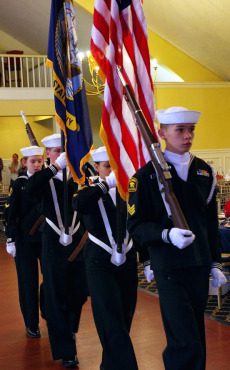All About Posting or Presenting Colors
The following information is from The Drill Master website.
Follow him on FaceBook at @DrillMasterTraining.
The American flag bearer is in charge and calls commands. Call commands nice and loud to bring attention to the colors.
Experience before aesthetics. Not if you have the luxury of each member of the team being around the same height, but for cadet and civil teams, it should come second to knowledge and experience. Yes, the team might look “off”, but it’s best to have knowledgeable members of the team in key positions rather than have aesthetics.
Waiting for the ceremony still requires proper protocol.
- Arrive at the site at least one hour early
- Practice while in your travel uniform (this ensures no one thinks the ceremony has already begun and gives the team time to figure out their movements)
- Change into ceremonial/Class A uniform
- Hang out* with equipment ready in-hand and all team members in their proper place (American flag at right or in front of other flags- yes, even just hanging around – cameras are everywhere)
- Ten minutes prior to show time, line up at staging position at Stand at Ease (or Parade Rest) ready to perform
Posting the colors is for special occasions. How special? That is up to the organization. Graduations are a special time, that would call for posting the colors. Weekly events would probably warrant pre-posted colors at the least or presenting the colors only.
The Show-n-Go. This is the honor guard term for presenting the colors for an informal/semi-formal event. The colors are pre-posted on the stage/front of the room and the color team enters, presents (Anthem), and then departs. No posting.
With the Show-n-Go, the colors do not matter. As long as the American flag pre-posted, the color team can present whatever they carry as their standard colors (American, State, etc.).
While colors can be and sometimes are posted outdoors, my experience leads me to recommend that you present and not post. The wind just never plays well with others. The members present and then stage the team for everyone to see. Sometimes this may not be a viable solution and you will have to have the event and location dictate how the color team handles the colors.
Note: As a rule of thumb, colors enter at Right Shoulder (Carry) and depart at Port Arms. Entering at Port is fine if necessary.
- Enter
- Halt in front of and facing audience
- Present Arms for National Anthem or Pledge (never both)
- Port Arms
- (Color bearers move to post colors and rejoin guards)
- Depart
The color team moves into position as normal, but the team does not execute Present Arms. The audience recites the Pledge at the prompting of the master of ceremonies. A member of the color guard does not being or recite the Pledge. You are at Attention and that requires silence except for commands.
NOTE: The Pledge and National Anthem DO NOT go together. It’s one or the other. DO not use both. If you do not have the ability to sing or play the Star Spangled Banner, then reciting the pledge is appropriate (except for military organizations- military in uniform do not recite the Pledge, they remain at Attention).
Retrieving the colors is reserved for the extra, extra formal occasions. Do not retire the colors for weekly or even monthly meetings. Retirement is for very formal galas or balls. Use the posting sequence in reverse.
- Enter
- Halt in front of and facing audience
- Color bearers retrieve colors and rejoin guards
- Present Arms for a few seconds (flags do not dip)
- Port Arms
- Depart
It’s a windy day. Your color guard is up next for the competition. You move into position on the drill, colors at Carry and rifles at Right Shoulder, pad and give the order to go to Present Arms. The rifles guards execute the Present Arms position, the American flag is flying in the breeze, and the spade at the top of the staff for the state flag, while it is being pushed forward, catches the American flag at the corner and the flag wraps around the point on the spade. If you notice in time, you realize that if either of the flags move independently, the American flag, made of nylon, will have a nice rip, or at least, a run that will render the flag useless, requiring the purchase of a new flag. What should happen next?
Fix it! The color team commander, the bearer of the American flag (only, no one else is ever the commander), must give an informational command to have the right or left rifle guard proceed to fix it. If need be, bring the staffs out of the harness cup/socket, proceed with whatever needs to be fixed and then carry on with the performance like nothing happened. The impression left on the judge/audience will be much better than if a disaster is left to happen.

